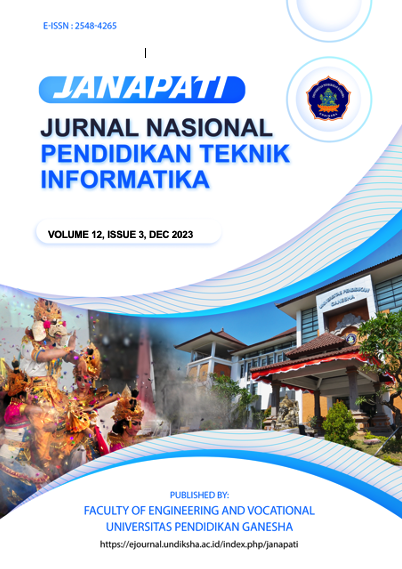Ceramic Firing Temperature Trajectory Monitoring System on IoT-Based Gas Furnace
English
DOI:
https://doi.org/10.23887/janapati.v12i3.69708Keywords:
Internet of Things, Ceramic Firing, Thermocouple Sensor, Monitoring SystemAbstract
This study introduces a novel system where a conventional ceramic furnace is upgraded with IoT capabilities, specifically utilizing NodeMCU and a thermocouple sensor. The integrated system enables real-time temperature monitoring, facilitating the correction of firing trajectory errors in the ceramic firing process. The sensors reading minimizes errors by detecting temperature changes with a maximum deviation of -2.5 °C and a minimum deviation of -1 °C. The average error ranges from 1.81% to 3.79%. The collected data is seamlessly transmitted to Google Spreadsheet for online monitoring. This comprehensive solution not only minimizes recording errors but also ensures the quality of final ceramic products by preventing issues such as cracks, breaks, black cores, and non-uniform sizes. The incorporation of NodeMCU, thermocouple sensors, and online monitoring represents a significant technological leap in optimizing ceramic firing processes for heightened precision and efficiency.
References
M. M. Subedi, “Ceramics and its Importance,” Himal. Physics, vol. 4, no. 4, pp. 80–82, 2013, doi: https://doi.org/10.3126/hj.v4i0.9433.
T. Matencio, “Importance of ceramic materials in our society,” Rev. Mater., vol. 25, no. 1, pp. 1–2, 2020, doi: 10.1590/s1517-707620200001.1001.
A. S. P. Utama, W. Tambunan, and L. D. Fathimahhayati, “Analisis Human Error pada Proses Produksi Keramik dengan Menggunakan Metode HEART dan SHERPA,” J. INTECH Tek. Ind. Univ. Serang Raya, vol. 6, no. 1, pp. 12–22, 2020, doi: 10.30656/intech.v6i1.2114.
Prima Yustana, Mengenal Keramik. Isi Press, 2018.
R. B. G. Soebroto, “Tungku Pembakaran Tipe ‘Api Berbalik’ Untuk Meningkatkan Kualitas Gerabah, Desa Selogabus Kecamatan Parengan Tuban,” Semin. Nas. Inov. dan Apl. Teknol. di Ind., pp. 377–384, 2019.
P. Supriatno, “Sistem Kontrol Pada Tungku Keramik Roller Hearth Kiln (Rhk),” J. Wawasan Ilm., vol. 9, no. 1, pp. 25–31, 2019.
K. K. Khaing, K. Srujan Raju, G. R. Sinha, and W. Y. Swe, “Automatic temperature control system using arduino,” Adv. Intell. Syst. Comput., vol. 1090, no. July, pp. 219–226, 2020, doi: 10.1007/978-981-15-1480-7_18.
D. P. Sari, S. Rasyad, A. Amperawan, and S. Muslimin, “Kendali Suhu Air Dengan Sensor Termokopel Tipe-K Pada Simulator Sistem Pengisian Botol Otomatis,” J. Ampere, vol. 3, no. 2, p. 128, 2018, doi: 10.31851/ampere.v3i2.2393.
I. W. G. Partamayasa, I. K. Gede Suhartana, and I. W. Supriana, “Perancangan Sistem Pengaturan Suhu Ruangan Otomatis Berbasis Mikrokontroler,” JELIKU (Jurnal Elektron. Ilmu Komput. Udayana), vol. 8, no. 1, p. 95, 2019, doi: 10.24843/jlk.2019.v08.i01.p12.
B. H. Wijaya, A. D. Asyiqin, and A. Damanuri, “Penggunaan Teknologi Dan Potensi Penerapan Internet Of Things (IoT) Dalam Pengembangan UMKM: Studi Kasus Resto Ayam Buldak,” Invest J. Sharia Econ. Law, vol. 2, no. 1, pp. 92–105, 2022, doi: 10.21154/invest.v2i1.4672.
Y. Efendi, “Internet Of Things (Iot) Sistem Pengendalian Lampu Menggunakan Raspberry Pi Berbasis Mobile,” J. Ilm. Ilmu Komput., vol. 4, no. 1, pp. 19–26, 2018, doi: 10.35329/jiik.v4i1.48.
M. Z. Elfirman and M. Alkaff, “Pemanfaatan Wireless Sensor Network Berbasis Internet of Things Untuk Monitoring Lahan Gambut Jarak Jauh,” J. Ilm. Ilmu Komput., vol. 13, no. 1, pp. 56–59, 2018.
I. Gunawan, T. Akbar, and M. Giyandhi Ilham, “Prototipe Penerapan Internet Of Things (Iot) Pada Monitoring Level Air Tandon Menggunakan Nodemcu Esp8266 Dan Blynk,” Infotek J. Inform. dan Teknol., vol. 3, no. 1, pp. 1–7, 2020, doi: 10.29408/jit.v3i1.1789.
Y. Wishnu Pandu Prayudha, S. Fadhil, and S. Novianto, “Rancang Bangun Sistem Pengukuran Alat Thermobath sebagai Alat Kalibrasi Temperatur dengan Sistem Arduino Uno,” J. Asiimetrik J. Ilm. Rekayasa Inov., vol. 4, pp. 25–34, 2022, doi: 10.35814/asiimetrik.v4i1.2541.
Maxim, “MAX31855 Cold-Junction Compensated Thermocouple-to-Digital Converter,” Sunnyvale, 2012. [Online]. Available: www.maxim-ic.com/MAX31855.related.
A. Fedorov, “Connection of Thermocouple (K-Type) to ESP8266/ESP32/Arduino,” 2019. .
F. A. Fhadillah, A. Andang, and N. Busaeri, “Sistem Kontrol Suhu Electric Muffle Furnace Menggunakan Sensor Thermokopel Type-K Berbasis Mikrokontroller Arduino Uno,” J. Energy Electr. Eng., vol. 113, no. 2, pp. 113–124, 2023.
A. M. A. Jiwatami, “Aplikasi Termokopel untuk Pengukuran Suhu Autoklaf,” Lontar Phys. Today, vol. 1, no. 1, pp. 38–44, 2022, doi: 10.26877/lpt.v1i1.10695.
A. J. Hidayat, I. Marzuki, and I. Wicaksono, “Rancang Bangun Pengendali Temperature Berbasis Arduino Uno Pada Ketel UAP di Pabrik Gula Wonolangan,” J. JISE, vol. 1, no. 1, pp. 17–22, 2022.
R. F. Maulana, M. A. Ramadhan, W. Maharani, and M. I. Maulana, “Rancang Bangun Sistem Monitoring Suhu dan Kelembapan Berbasis IOT Studi Kasus Ruang Server ITTelkom Surabaya,” vol. 1, no. 3, pp. 224–231, 2023.
F. A. Deswar and R. Pradana, “Monitoring Suhu Pada Ruang Server Menggunakan Wemos D1 R1 Berbasis Internet of Things (Iot),” Technol. J. Ilm., vol. 12, no. 1, p. 25, 2021, doi: 10.31602/tji.v12i1.4178.
Z. Zakaria, F. Fauzi, I. Irhamni, and E. Iswardy, “Rancang Bangun Sistem Pengontrolan Lampu Berbasis Komputer Dan Arduino Untuk Aplikasi Smart Home,” J. Komputer, Inf. Teknol. dan Elektro, vol. 6, no. 1, pp. 26–31, 2021, doi: 10.24815/kitektro.v6i1.21241.
T. F. Arya, M. Faiqurahman, and Y. Azhar, “Aplikasi Wireless Sensor Network Untuk Sistem Monitoring Dan Klasifikasi Kualitas Udara,” Sistemasi, vol. 7, no. 3, p. 281, 2018, doi: 10.32520/stmsi.v7i3.312.
Downloads
Published
How to Cite
Issue
Section
License
Copyright (c) 2024 I Wayan Oka Prayasa, Agus Putu Abiyasa, I Putu Angga Kristyawan

This work is licensed under a Creative Commons Attribution-ShareAlike 4.0 International License.
Authors who publish with Janapati agree to the following terms:- Authors retain copyright and grant the journal the right of first publication with the work simultaneously licensed under a Creative Commons Attribution License (CC BY-SA 4.0) that allows others to share the work with an acknowledgment of the work's authorship and initial publication in this journal
- Authors are able to enter into separate, additional contractual arrangements for the non-exclusive distribution of the journal's published version of the work (e.g., post it to an institutional repository or publish it in a book), with an acknowledgment of its initial publication in this journal.
- Authors are permitted and encouraged to post their work online (e.g., in institutional repositories or on their website) prior to and during the submission process, as it can lead to productive exchanges, as well as earlier and greater citation of published work. (See The Effect of Open Access)







